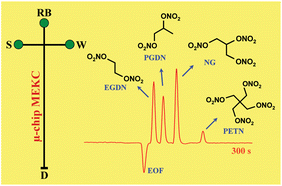Rapid and sensitive measurements of nitrate ester explosives using microchip electrophoresis with electrochemical detection
Abstract
This article describes an effective microchip protocol based on electrophoretic-separation and

* Corresponding authors
a Biodesign Institute, Arizona State University, Tempe, AZ 85287, USA
b Departamento de Química e Física Molecular, Instituto de Química de São Carlos, Universidade de São Paulo, São Carlos, SP, Brazil
c Department of Chemical Sciences and Technology, University of Udine, Udine, Italy
d
Department of NanoEngineering, University of California – San Diego, La Jolla, CA 92093, USA
E-mail:
josephwang@ucsd.edu
This article describes an effective microchip protocol based on electrophoretic-separation and

 Please wait while we load your content...
Something went wrong. Try again?
Please wait while we load your content...
Something went wrong. Try again?
E. Piccin, N. Dossi, A. Cagan, E. Carrilho and J. Wang, Analyst, 2009, 134, 528 DOI: 10.1039/B813993H
To request permission to reproduce material from this article, please go to the Copyright Clearance Center request page.
If you are an author contributing to an RSC publication, you do not need to request permission provided correct acknowledgement is given.
If you are the author of this article, you do not need to request permission to reproduce figures and diagrams provided correct acknowledgement is given. If you want to reproduce the whole article in a third-party publication (excluding your thesis/dissertation for which permission is not required) please go to the Copyright Clearance Center request page.
Read more about how to correctly acknowledge RSC content.
 Fetching data from CrossRef.
Fetching data from CrossRef.
This may take some time to load.
Loading related content
